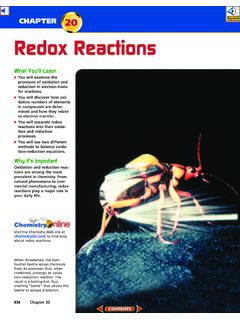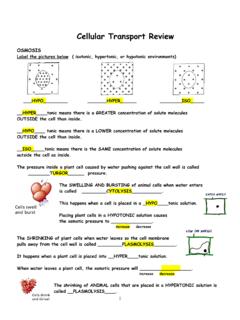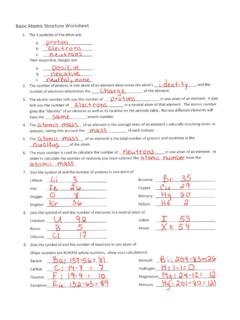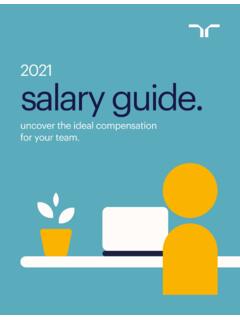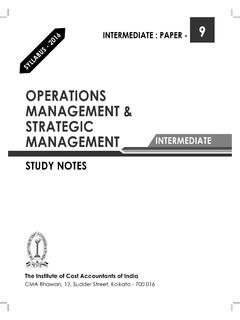Transcription of In this chapter, you’ll learn about the peninsula’s
1 Teachers Curriculum Institute The Geography of the Arabian Peninsula Name and Date: _____ Text: HISTORY ALIVE! The Medieval World Introduction Our study of Islam begins with the Arabian Peninsula, where Islam was first preached. The founder of Islam, Muhammad, was born on the peninsula in about 570 In this chapter, you ll learn about the peninsula s geography and the ways of life of its people in the sixth century. The Arabian Peninsula is in southwest Asia, between the Red Sea and the Persian Gulf. It is often called Arabia. Along with North Africa, the eastern Mediterranean shore, and present day Turkey, Iraq, and Iran, it is part of the modern Middle East. Most of the people living in Arabia in the sixth century were Arabs.
2 Some Arabs call their home al-Jazeera, or the Island. But it is surrounded by water on only three sides. The Persian Gulf lies to the east, the Red Sea to the west, and the Indian Ocean to the south. To the north are lands bordering the Mediterranean Sea. These lands serve as a land bridge between Africa, Asia, and Europe. Imagine that you are flying over the Arabian Peninsula. As you look down, you see vast deserts dotted by oases. Coastal plains line the southern and western coasts. Mountain ranges divide these coastal plains from the desert. The hot, dry Arabian Peninsula is a challenging place to live. In this chapter, you will study the geography of Arabia and its different environments. You ll see how people made adaptations in order to thrive there.
3 The Importance of the Arabian Peninsula and Surrounding Lands Arabia lies at the crossroads of Asia, Africa, and Europe. In ancient times, great civilizations grew up in the lands around Arabia. To the northeast, Sumerians built their complex civilization along the valleys of the Tigris and Euphrates rivers in present day Iraq. To the west, the Egyptians built their society on the banks of the Nile River in North Africa. Later, the Greeks, Romans, and Persians all had a major influence on the Middle East. Teachers Curriculum Institute The Geography of the Arabian Peninsula Name and Date: _____ Text: HISTORY ALIVE! The Medieval World A great deal of trade passed through this region. Traders carried silk from China and jewels, cotton, and spices from India.
4 From Africa came ivory and gold. The Romans sent glass and gold east to China. As early as 2000 , the people of Arabia served as middlemen in the trade between these lands. Arab traders used camels to carry goods through the desert in caravans. Along the coasts, merchants sent ships to distant marketplaces. Serving as a link between such diverse regions exposed Arabia to new goods and ideas. Arabs also shared their own knowledge along these trade routes. The influence of Arabia became far more powerful with the rise of Islam. From its central location in Arabia, Islam spread rapidly throughout the Middle East, North Africa, and parts of Europe. Great cities like Cordoba in Spain, Cairo in Egypt, and Baghdad in present day Iraq became important centers of the Islamic world.
5 Knowledge, ideas, technology, and goods flowed through Arab lands. For example, Arabs brought knowledge of paper making to Europe from China. Europe also benefited from ancient Greek learning that was preserved and enhanced by Arab scholars. And Islam itself would become one of the largest and most influential religions in the world. What was the birthplace of Islam like? In the rest of this chapter, we ll look at Arabia s geography. The Desert about three quarters of the Arabian Peninsula is covered by desert. Besides vast seas of sand, the desert includes plains and plateaus. Environment The hot, dry desert environment is very harsh. Summer temperatures often rise above 120 degrees Fahrenheit. Winter and nighttime temperatures can drop below freezing.
6 Annual rainfall does not surpass more than 3 to 4 inches, and droughts can last for years. When the rain comes, it often falls as violent storms, sometimes causing flash floods. These infrequent waters cause clumps of grass and pockets of low shrubs to spring to life. The harsh desert environment covers much of the Arabian Peninsula. The deserts include plains and plateaus like those seen below. Teachers Curriculum Institute The Geography of the Arabian Peninsula Name and Date: _____ Text: HISTORY ALIVE! The Medieval World The desert is often swept by windstorms. Powerful winds may flare up suddenly, causing blinding sandstorms. The winds transform the landscape, sometimes creating sand dunes that rise 800 feet into the sky.
7 Adaptations Many Arabs in the sixth century lived in towns and villages. Others, however, were nomads. Arab nomads, called Bedouins, migrated through the desert raising sheep, goats, and camels. Upon finding a place for their herds to graze and drink, they set up tents. They moved on when the animals had eaten most of the vegetation. The camel called the ship of the desert was the Bedouins main method of transportation. Camels could survive for days without water, eat almost anything, and carry heavy loads for long distances. Bedouins clothed themselves in loose-fitting long gowns and cotton headdresses to protect against dust, heat, and flies. They got almost everything they needed from their herds. They drank milk, made yogurt and cheese, and sometimes ate meat.
8 The animals provided wool and hair for clothing, blankets, and tents, as well as leather hides. To obtain other items, like grain or weapons, Bedouins traded their animal products with merchants from the towns. Some Bedouins controlled the valuable trade routes that linked towns and villages. Merchants operated caravans that carried goods across the desert. Sizable towns, like Makkah (Mecca) in western Arabia, developed as markets and resting places for the caravans. The Oases The desert is dotted with oases, areas where fresh water is available. Oases are important because they provide plant life and shade as well as water. Environment Oases occur in areas where water has been trapped under the ground. The water seeps to the surface as a spring or waterhole.
9 On these fertile lands, plant life sprouts up, particularly grass and shrubs. Oases vary in size, ranging from a few acres to large areas of land. Adaptations For centuries, nomads traveled from oasis to oasis in search of water and vegetation for their herds. Realizing they could grow Oases provide water and plant life in the desert environment. Adaptations for living in the desert revolve around oases. Teachers Curriculum Institute The Geography of the Arabian Peninsula Name and Date: _____ Text: HISTORY ALIVE! The Medieval World crops at the oases, some nomads gave up their wandering lifestyle to become sedentary. To obtain more water for the crops they planted, they dug wells deep into the ground. Oasis dwellers grew fruits such as dates and peaches, and grains to make bread.
10 The date palm tree thrived in Arabia, and it became an invaluable resource. Palm leaves offered shade, while dates were a source of food. Farmers used palm wood to build homes. They used leaves for thatch roofs, fibers for rope, hollowed-out trunks for irrigation pipes, and various parts of the tree to fuel fires. The date palm was so useful that it was called the mother and aunt of the Arabs. A number of towns developed around oases, linked by tracks through the desert. Many of these towns evolved into small trading centers. Farmers bartered (traded) their crops for the goods the nomads brought, like milk, meat, and camel hair. Nomads either used these crops themselves or traded them elsewhere in the region. In time, merchants became an important part of town life.







